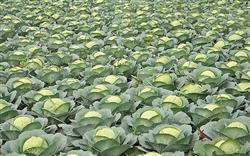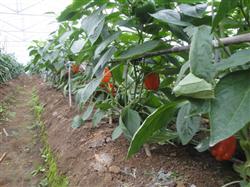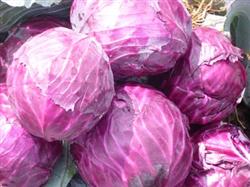What do you need to pay attention to when planting purple cabbage?

What should we pay attention to when planting purple cabbage? Compared with common cabbage, purple cabbage has the characteristics of longer growth period, compact heading, bright color, storage and transportation resistance, good quality and so on. First, the regional choice of purple cabbage likes cold, more hardy, and belongs to low temperature, long sunshine, natural cross-pollination vegetables. Seed production requires flat and fertile land, convenient irrigation, few diseases and insect pests and there are no other plots of cabbage, cauliflower and broccoli within 2000 meters. 2. Seedling management 1. The suitable sowing date is in North China, the middle-maturing varieties are suitable to sow in the open field in the first and middle of September, the late-maturing varieties should be in advance, and the early-maturing varieties should be postponed appropriately. 2. Cultivating strong seedlings of purple cabbage can sprout in 4 days after sowing. The rainy season is just over, the temperature is also suitable, and the seedlings are generally in good condition. However, in order to cultivate strong seedlings, we should still pay attention to: (1) after the true leaves grow to 3 leaves and 1 heart, the seedlings should be divided and planted in time, and the row spacing is (6 Mel 8) × 8 cm. (2) pay attention to the change of air temperature to prevent the seedlings from growing and weakening caused by high temperature. (3) spraying in time to prevent seedlings from being damaged by diseases and insect pests. 3. Post-autumn management techniques when the true leaves grow to 7 mures and 8 leaves, the purple cabbage seedlings are inverted in an improved sunny bed or solar greenhouse according to the plant spacing of 25 mures and 30 centimeters, in order to ensure safe overwintering and raise strong seedlings planted in spring. 1. Before applying basic fertilizer, per mu, human manure, poultry manure or livestock manure and other organic fertilizers mixed with soil are applied to 3000 million kilograms per mu, calcium superphosphate 30 to 50 kilograms, plant ash to 100 kilograms, shallow ploughing and raking flat. 2. Temperature control: buckle the film in time at the end of October, and keep the temperature above 15 ℃ in daytime and 5 ℃ at night during overwintering. On the one hand, the growth of seedlings should be strictly controlled to prevent high temperature seedlings from being too large, on the other hand, temperature control should not be too low to prevent frostbite or vernalization from being completed ahead of time and early bolting. 3. Water management and planting water should be irrigated enough, and 1 water should be irrigated in time after slowing down the seedling. Purple cabbage is suitable to grow in a humid environment, and the best soil moisture of the seedling bed is 70% and 80%. 4. after winter, the standard purple cabbage grows steadily and slowly in the greenhouse, and the plant should reach more than 20 leaves in the first and middle of March. The leaves are large and thick, the stems are stout, the internodes are short, the roots are well developed, there are no diseases and insect pests, and the heart leaves are clasped to form small balls. 4. Planting management techniques 1. 10 days before planting, the purple cabbage in the greenhouse should be released regularly and exercised at low temperature, so that it can resist the influence of cold current in late spring and grow normally after planting. 2. The soil was thawed and planted in the open field in time after the soil thawed in the middle and last ten days of March in the northern region, the row spacing was (50mur60) × 50cm, and 2000mu 2500 seedlings were planted per mu. Because the temperature is still relatively low after planting, the seedlings are generally not watered in the early stage after watering to promote the hairy roots. Slow seedling plants enter the heading stage, with the rapid increase of leaf ball, the number of irrigation should be increased, and the amount of irrigation should be increased, combined with the application of urea 10mur15kg each time to promote plant growth and leaf ball formation. 3. The plants with purple-red leaf bulb, short stem disc, small internodes, few outer leaves, early bulb wrapping, compact heading, no diseases, insect pests and cleavage were selected as seed collection plants, and the diseased and inferior hybrid plants which did not accord with the characteristics of this variety were strictly eliminated. In the middle and late April, a knife was used to cut the cross at the top of the bulb to expose the growing point, sometimes several more times, so that the main bolting could be pulled out smoothly. Seed and plant management and harvest 1. Set up some supports in time after bolting in seed production to prevent lodging and breaking of flower stems. 2. Watering and topdressing before the first flower, spraying regularly to control insects. Purple cabbage can not be short of water at flowering stage, and irrigation can be reduced in the middle and later stage of pod setting. In March, the seed pods began to be harvested after they turned yellow at the beginning of July, and a batch of mature pods were harvested in time. In North China, when the rainy season is coming, it is necessary to put it in a dry place after ripening and threshing for 5 days, which is generally divided into 3 times and 4 times. Three years' practice has proved that using this technical method to collect purple cabbage varieties can make full use of the control means of indoor temperature in the greenhouse in winter, and avoid the unfavorable factors such as freezing, rotten ball or dryness that may occur in pseudo-planting completely adult plants, and save labor and effort. At the same time, it can ensure the purity of commercial varieties and obtain high yield of seed production. Click to get more cabbage planting techniques click to get more vegetable planting techniques
- Prev

How to remove the sweet pepper razor?
How to remove the sweet pepper razor? Please introduce that in the production process of a large crop of sweet pepper, many vegetable farmers are accustomed to removing all the seeds from the plant before setting fruit, resulting in insufficient nutrition supply and difficult fruit setting of sweet pepper. Recently, the reporter in Shouguang city street Yangzhuang village vegetable farmer Xiao's greenhouse.
- Next

How to grow purple cabbage without pollution?
How to grow purple cabbage without pollution? Please give technical guidance to purple cabbage alias red cabbage and purple cabbage. A variety of Brassica oleracea in the cruciferous family that forms purple leaf balls and is a biennial herb. Native to the Mediterranean coast. Take purple leaf ball as edible organ, contain all kinds of vitamins and minerals, especially.
Related
- Where is it suitable to grow horseradish in China? it is expected to see the middle altitude horseradish in Alishan.
- How to prevent tomato virus disease reasonably? (Control methods included)
- Many people like to plant towel gourd on the balcony. What are the main points of this method and management?
- What crops can chili peppers be mixed with?
- Fertilization techniques and matters needing attention in Tomato
- What are the grafting techniques for peach seedlings in spring?
- Harm and control methods of root swelling disease of Chinese cabbage
- What are the pests of sweet potatoes? How to prevent and cure it?
- Symptoms, causes and Control methods of navel Rot in Tomato
- The cause of "Cucumber rotten bibcock" in Farmers' planting Cucumber and its Control Plan

